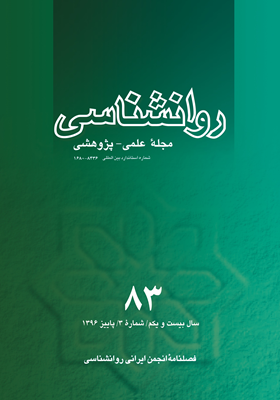نقش توانمندیهای هیجانی و شهروندی در پیشبینی عملکرد شغلی وظیفهای و زمینهای پرستاران
محورهای موضوعی :
1 - گروه روانشناسی دانشگاه تربیت مدرس، تهران.
کلید واژه: توانمندی های هیجانی, توانمندی های شهروندی, روانشناسی مثبت, عملکرد شغلی وظیفه ای, عملکرد شغلی زمینه ای,
چکیده مقاله :
این پژوهش باهدف تعیین نقش توانمندیهای هیجانی و شهروندی در پیشبینی عملکرد شغلی پرستاران انجام شد. بدين منظور 157 نفر بهصورت تصادفي ساده از پرستاران بیمارستانهای دولتی شهر اصفهان بهعنوان نمونه انتخاب شدند. ابزارهای پژوهش سیاهه توانمندیها و ارزشها در عمل (پیترسون و سلیگمن ، 2003)، فهرست وارسی عملکرد وظیفه ای (بیرنه و همکاران، 2005) و فهرست وارسی عملکرد زمینه ای (کونوی، 1999) بودند. تحلیل ضریب همبستگی پیرسون پژوهش نشان داد که بین توانمندیهای هیجانی و شهروندی و عملکرد شغلی وظیفهای و زمینهای رابطه معنادار وجود دارد (0/001>P). نتایج تحلیل رگرسیون گامبهگام نشان داد که پشتکار و راستکاری عملکرد شغلی وظیفهای و راستکاری و پیشگامی، عملکرد شغلی زمینه ای را پیشبینی میکنند. این یافته ها میتواند جهت افزایش عملکرد وظیفه ای و زمینه ای مورداستفاده قرار می گیرد.
This research has been carried out to study the role of emotional and civic strengths in predicting task and contextual performance in workers. Within this scope, 157 employees were randomly selected from the Nurses in public hospitals of Isfahan as the research sample. The instruments used in this study were the Values in Action- Inventory of Strengths (VIA-IS, Peterson & Seligman 2003), Task Performance Checklist (Byrne et al. 2005) and Contextual Performance Checklist (Conway, 1999).The analysis of r-Pearson’s correlation revealed positive relationship between the emotional and civic strengths with task and contextual performance (p<0/001). Stepwise regression results were indicated that persistence and honesty predicted task and honesty and leadership predicted contextual performance. These findings could be used in organizations to increase task and contextual performance.

